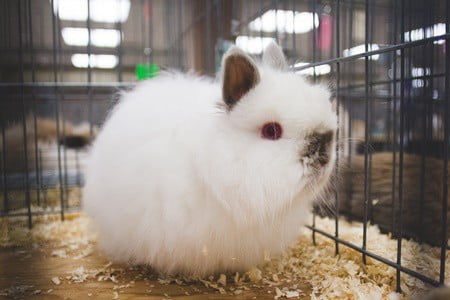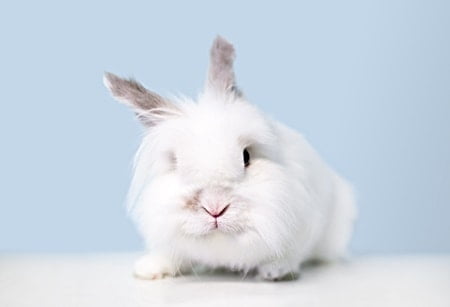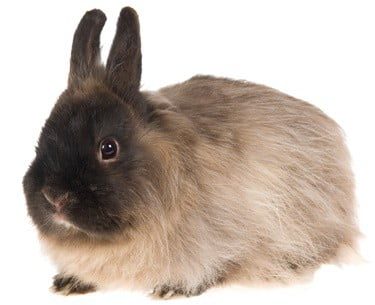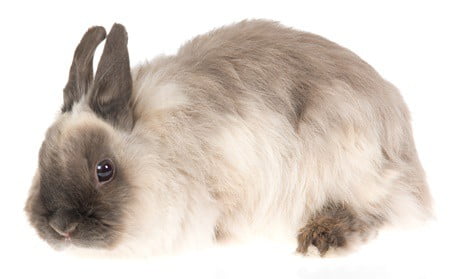The Jersey Wooly is a popular rabbit renowned for its playful and docile nature. These rabbits love affection and attention, and always enjoy snuggling on their keepers’ laps. They are also one of the most commonly exhibited rabbits in national and local shows in the U.S.
The Jersey Wooly rabbit is a dwarf breed, weighing between 1 to 3.5lbs. It’s affectionately called the “mug head” because of its square, bold head. The Jersey Wooly is a surprisingly low maintenance breed, despite its thick coat. It only needs to be brushed once a week, and more often during shedding seasons.
The Jersey Wooly is nicknamed the “no-kick” bunny because of its even-tempered nature. Although it’s a relatively newer breed, it’s really popular in the United States. Once you understand how to take care of a Jersey Wooly, your pet can lead a healthy and happy life in its new home.
Jersey Wooly Rabbit Care
| Breed Name | Jersey Wooly |
| Country of Origin | United States of America |
| Breed size | Small |
| Weight | Female: 2.5 to 3.5lb. Male: 2.5 to 3.5lb |
| Lifespan | 7-10 years |
| Physical Appearance | Small, compact, semi-arched body Square, bold head Small, erect ears (2-3 inches) Long shaggy coat |
| Grooming requirements | Needs to be brushed once a week |
| Colors | Agouti, self, broken, shaded, and tan pattern |
| Temperament | Calm and playful. Enjoys attention and cuddles |
| Special requirements | Should be housed indoors |
The Jersey Wooly is one of the most docile rabbits. It’s a popular show rabbit because of its thick, Angora-like coat, but it also makes an adorable pet because of its love for human attention and care.
The Jersey Wooly is a small rabbit developed by crossing the French Angora and the Netherland Dwarf. The resulting rabbits were made smaller with the influence of the dwarfing gene.
Unlike the Angora rabbit, Jersey Woolys do not need to be sheared or trimmed. They’re a low-maintenance breed that only need to be brushed once a week and more often during shedding seasons to avoid wool block.
Size and Appearance
A fully grown Jersey Wooly weighs around 2.5 to 3.5 pounds. 3 lbs. is considered the ideal weight of a mature Jersey Wooly.
Jersey Wooly rabbits have a compact, semi-arched body type. They have small and erect ears that measure about 2.5 to 3 inches long. For exhibitions, 3 inches is the maximum length allowed according to the ARBA’s Standard of Perfection. For rabbit shows in the U.S., the head and ears of a Jersey Wooly earn the most points.
Jersey Wooly rabbits have a squarish and bold head, which is the reason for their popular nickname “mug-head.”
Coat
Unlike other thick-coated rabbit breeds, such as Angoras, Jersey Wooly rabbits do not require any shearing or trimming to maintain their wool.
To keep your Jersey Wooly’s coat tangle and matt-free, you need to brush its coat at least once a week during non-shedding seasons. Once spring arrives, you’ll need to brush adult Jersey Woolys more often as they tend to shed more during this time.
If your rabbit’s coat gets dirty, spot clean with a clean, damp cloth. Never give a rabbit a full bath as this can lead to stress and life-threatening cardiac issues.
Use rabbit-safe clippers/trimmers instead of scissors in case your rabbit’s coat gets severely matted and if spot cleaning and detangling doesn’t work. Using scissors can accidentally cut your rabbit’s sensitive skin, causing stress and fear during grooming.

Colors
The ARBA recognizes the Jersey Wooly is 6 color groups:
| Agouti: | Chestnut, opal, chinchilla, and squirrel |
| Broken: | Any variety with white |
| Self: | Black, chocolate, blue, lilac, REW (red-eyed-white) and BEW (blue-eyed-white) |
| Shaded: | Tortoiseshell, blue tortoiseshell, seal, Siamese sable, sable point, and smoke pearl |
| Tan Pattern: | Blue otter, black otter, sable marten, smoke pearl marten, blue silver marten, black silver marten, lilac silver marten, and chocolate silver marten |
| AOV: | Pointed white blue and pointed white black |
Lifespan
The average lifespan of this breed depends on many factors, the biggest ones being genetics and quality of care. It’s not uncommon for Jersey Wooly rabbits to live anywhere around 7 to 10 years if given proper care.
A common myth is that rabbits that have had litters die sooner. This hasn’t been proven scientifically. Many Jersey Wooly owners have reported owning healthy rabbits that have had multiple litters and unhealthy Jersey Woolys that have had no litters.
However, spaying or neutering, coupled with proper healthcare can expand their lifespan. Unneutered or unspayed rabbits have a higher likelihood of developing life-threatening reproductive system tumors and cancers.
Behavior and Temperament
Jersey Woolys are known for their affectionate and playful nature. As pets, they may range from being laid-back lap rabbits to curious explorers.
They’re known as no-kick rabbits because they’re not aggressive and do not bite or kick their handlers. This makes Jersey Woolys good family pets for individuals with children of any age. However, young children should be supervised when they’re handling rabbits, especially small breeds like the Jersey Wooly as they can be highly fragile and easily stressed.
Because of their affectionate nature, they also make remarkable pets for seniors or retirees, first-time pet owners, couples and singles who’d enjoy a cuddly companion.
Jersey Woolys are social rabbits. Therefore, they’re happiest when they’re in pairs or trios. Some rabbits form inseparable pairs as they’re bonded quite closely to one another. If your Jersey Wooly isn’t bonded, care should be taken before it is matched with another rabbit. You may have to house your Jersey Wooly separately while it gets to know its new friend.
If a Jersey Wooly is kept single, it will need plenty of time and human attention. However, human companionship may not be enough to replace the interaction it has with its own kind.
Your Jersey Wooly should be given free access to you in your home, whether it involves it following you around in the kitchen, or cuddling with you on the couch.
Will a Jersey Wooly Get Along with Cats and Dogs?
Jersey Woolys often get along with other household pets. However, because of their small size, you’ll have to be extra cautious about their safety.
Some cats and dogs have high prey instincts, causing them to act aggressively towards small rabbits.
Spaying And Neutering
Some rabbits may mark their territory by spraying. This behavior can be suppressed or eliminated with spaying or neutering. Spaying and neutering also make rabbits calmer, resulting in fewer behavioral problems.
Your rabbit should be spayed or neutered at 4-6 months of age. In addition to curbing behavioral issues, it also eliminates unwanted pregnancy, as well as reproductive system cancer and infections.
Exercise and Play
Rabbits are most active at daybreak and sunset. The Jersey Wooly is a curious and playful breed and most free-roaming individuals may greet you and your guests at the door.
Jersey Woolys are highly intelligent and love learning new tricks. They also enjoy chewing and digging. Therefore, it is important that you provide appropriate toys for it to chew on, while being on top of its dental health.

Examples of rabbit-safe toys include an empty roll of toilet paper or a rabbit-safe block of wood. You can also find a wide array of mentally stimulating rabbit toys in your local pet store.
Anything that your rabbit is not supposed to gnaw on, such as wires and wooden furniture should be protected or kept out of reach.
Jersey Woolys enjoy spending time with their owners and getting their attention. Therefore, try to spend at least 15 minutes of one-on-one play time with your pet.
Do Jersey Woolys Like Being Handled?
Jersey Woolys love being picked up and being petted. Avoid letting young children pick up a Jersey Wooly as improper handling can easily damage its delicate back and cause severe stress.
However, not all Jersey Wooly’s have the same personalities. Occasionally, a Jersey Wooly may not want to be held. If it’s not in the mood, it will let you know with a grunt. In such cases, it’s best to respect your rabbit’s wishes and give it the space it needs.
If your once affectionate rabbit suddenly becomes unsociable or aggressive, it may be a sign of an underlying health condition. Consult your vet and look out for other signs that may help your vet diagnose the problem.
Litter Training
Most rabbits have a potty corner in their cage where they prefer to eliminate. Once you place a litter box in their potty corner, they’ll quickly make a connection and start eliminating in there.
You may have to confine your rabbit to its enclosure until it is completely litter trained. Some owners recommend placing multiple litter boxes around the house so that they don’t have to go too far to do their business.
Housing and Environment
Because of its small size, a Jersey Wooly should only be housed indoors. This will protect them from predators, extreme temperatures (hot and cold), and other outdoor threats.
In order for its inquisitive personality to flourish, it will also need outdoor enclosure time and to spend time with its human companions. Your rabbit should be allowed to hop about and play in a rabbit-safe room.
Rabbit-proofing a room involves removing or covering any electrical wires. They are keen gnawers and can get electrocuted if they chew on a wire.
You can also let them roam around outside in a secure, fenced yard under your supervision. Allow your rabbit to roam outside in an area where it can get sunlight and fresh air.
Always keep an eye out for predators such as raccoons, snakes, foxes, and neighborhood cats as they can seriously harm a small rabbit.
Setting Up a Jersey Wooly Cage
Your Jersey Wooly’s enclosure should be large enough for it to comfortably stretch. This shouldn’t be too difficult because of its small size.
Look for a minimum size of 1 foot per 1 pound of your rabbit’s body weight. If your rabbit weighs 3lbs, its cage needs to have an area of at least 3 square feet. The width of the cage should be 1.5 times the length and the length should be 3 times the length of a fully grown Jersey Wooly.
Keep in mind that the cage isn’t going to house your rabbit only. It will need to have enough room for its food and water dishes, it’s litter box and a box for it to sleep and rest in. Ideally, you should look for a floor space of at least 6 feet for a fully grown rabbit.
Aquariums and cages with solid walls are not suitable for rabbits as it restricts their airflow. Look for a wire enclosure with a plastic or solid, carpeted bottom. Avoid wire-bottomed cages as the tiny feet of a Jersey Wooly can easily get stuck to the floor, causing injury and pain. Wire floors are also notorious for causing sores at the bottom of rabbits’ feet.
Bedding
Your pet will need an area to sleep in on top of the floor of the cage. Rabbits tend to dig and eat their bedding. Therefore, make sure you choose a material that is safe for rabbits to eat. If you’re carpeting the floor of your rabbit’s cage, choose fleece as it won’t block its digestive tract if it eats it.
Whether you choose a carpeted, wood, or plastic flooring, you need to place a deep layer of bedding on the floor. The best rabbit-safe bedding options include timothy or meadow hay. You can also use a natural fiber blanket or any other bedding made with organic material.
You must avoid using harmful materials, such as wood shavings, pine products, cat litter, newspaper, cardboard, or cedar for bedding. There should be enough bedding for your rabbit to move around and burrow in.
Bedding should be spot-cleaned every day to clear it off food debris, water, urine, and fecal droppings. Replace the bedding once every week, or more often, if needed.
Litter Box
It’s best to allow your rabbit to use a litter box to make cleanup easier. Place a medium-sized cat litter pan inside your rabbit’s cage in an area where it prefers to eliminate. Place fresh hay inside the litter tray, with a layer of bedding under the hay.
Rabbit litter boxes need two sides: a bathroom side where it will do its business and a kitchen side where it will nibble hay in the litter box. Keep the bathroom side away from the kitchen side to avoid contamination.
Hiding Places
Rabbits, especially smaller breeds such as the Jersey Wooly are easily frightened and stressed. They prefer to hide when they hear loud noises or feel that a predator is nearby.
Placing hiding places inside your rabbit’s enclosure and your home can help your Jersey Wooly feel more secure when it feels stressed or scared.
Hiding places can include enclosed spaces away from sounds, drafts, and strong lights. Keep hiding places away from high-traffic areas of your house. Hiding places should have two openings, or your pet will not use it.
An easy hiding place is a cardboard box with two openings, or tunnels made with cardboard tubes.

Diet
Jersey Wooly rabbits are herbivorous. So, their diet should consist of hay, vegetables, pellets, and some fruit.
| Hay | Unlimited access |
| Leafy greens | ½ to 1 loose cup per day |
| Pellets | 1/8 to ¼ cup per day |
| Treats (fruits and starchy vegetables) | Not more than 1 tbsp per day |
Hay
Hay is essential for rabbits and should make up 80% of your Jersey Wooly’s diet. It is packed with nutrient-rich fiber that also ensures the proper functioning and motility of the digestive tract.
Rabbits spend a large proportion of their time chewing on hay, which helps keep their teeth trimmed and their dental health in check.
Grass hays, such as timothy, orchard and oat should be provided in unlimited quantities. Alfalfa hay is high in calories and should only be given to a Jersey Wooly occasionally.
Fresh Pellets
Jersey Wooly rabbits also need pellets to keep up with their nutrient demands. Choose a high-quality pellet that’s high in fiber and low in carbohydrates. Avoid mixes that include unhealthy, high-calorie or high-carbohydrate ingredients, such as dried fruit, corn or seeds.
An adult Jersey Wooly can have 1/8 to ¼ of a cup of fresh pellets every day.
Leafy Greens
Jersey Wooly rabbits need green leafy vegetables for added fiber, vitamins and minerals. Leafy greens are also packed with moisture, which helps prevent dehydration in rabbits.
Carrot tops, broccoli stems, bok choy, lettuce (except iceberg lettuce) and dandelion greens make excellent leafy greens for a pet Jersey Wooly.
Feed no more than ½ to 1 cup of loose greens every day, spreading it over 3-4 portions.
Treats
Treats, such as fruits and starchy vegetables, should be limited in a Jersey Wooly’s diet. Because Jersey Wooly’s are so small, they can only be given 1 tablespoon of treats 3-4 times a week. Going over this limit can lead to obesity and related issues in your pet, taking years away from its life.
With fresh foods, always make sure you wash them thoroughly to remove any pesticides and harmful chemicals. Remove uneaten fresh foods at the end of the day to prevent rotting. Mold can kill rabbits.
Water
Your rabbit should have access to fresh water, either in a stable water dish or a sipper bottle in its cage. Most rabbits prefer ceramic dishes. If the water from the bowl gets tipped or gets your rabbit’s hay wet, change the hay immediately. Never let hay get spoiled or wet inside a rabbit’s cage.
Health Issues
Dwarf rabbits can live up to 10 years if kept in proper conditions and given a healthy diet. Like other pets, the Jersey Wooly requires routine veterinary care to avoid common health conditions seen in dwarf rabbits.
Wool Block
Jersey Wooly rabbits are not as prone to wool blocks as other thick-coated rabbits, such as English Angoras. However, because they have shaggy coats, they’re still somewhat at risk.
Rabbits are fastidious groomers and keep themselves clean by licking their fur. Rabbits don’t regurgitate their wool. Anything a rabbit swallows, stays in its digestive tract until it is ready to be eliminated.
An accumulation of wool inside the stomach can cause bloating and feeling of fullness, resulting in loss of appetite, starvation, and death. You may also notice fewer droppings in your rabbit’s cage.
To prevent wool block, brush your rabbit every week, and more often during shedding seasons.
Dental Disease
Jersey Woolys are particularly suspectable to dental problems because of their smaller heads and longer jaws. This combination can lead to misalignment issues, such as mandibular prognathism.
Mandibular prognathism results in abnormal patterns of dental damage, causing altered teeth positioning and elongated teeth. Signs include, loss of appetite, weight loss, dribbling, and digestive tract issues.
Your vet may fix your rabbit’s teeth to improve misalignment under anesthetic. They may also remove any sharp spikes which can easily cut into the soft tissues of the tongue and cheeks.
Respiratory Tract Disorders
Jersey Wooly rabbits are vulnerable to respiratory conditions because the roots of their upper teeth are situated just below their sinuses. Any inflammation of the gums or teeth can lead to sinus infections.
Other respiratory conditions include snuffles, which cause a runny nose, rapid breathing, coughing and discharge from the eyes. Snuffles is caused by the Pasteurella bacteria, and can be transferred to other rabbits. Early treatment with antibiotics can help clear up the infection.
Bladder Problems
Unlike other animals, rabbits absorb all the calcium they obtain from their diets and expel it through their bladders. Unfortunately, this can result in the buildup of calcium in the bladder, also called bladder sludge.
Jersey Woolys are highly susceptible to developing bladder stones. Symptoms include blood in the urine, urine scald, and squealing or vocalizing while passing urine.
Bladder problems are easy to treat if detected early. Bladder sludge can be flushed out of the bladder with fluids and bladder stones can be surgically removed. For bladder infections, a course of antibiotics can help.
To avoid bladder issues in Jersey Wooly rabbits, a hay-rich diet with high quality pellets containing the right amount of calcium should help.
Flystrike
Jersey Wooly rabbits are more at risk of flystrike because eggs can easily adhere to their long fur, especially if tangled. Rabbits that aren’t healthy or are feeling unwell are more at risk because of their poor grooming routines.
Catching flystrike early can make treatment more effective. However, it is important to address the underlying cause of the flystrike to eliminate the problem successfully. For example, if your rabbit isn’t grooming itself because of a pre-existing condition, such as obesity of dental issues, you may have to treat the issue to avoid flystrike.
Uterine Cancer
Jersey Wooly rabbits are susceptible to uterine cancer, the symptoms of which include loss of appetite, blood in the urine, stillbirths and fertility issues. In some cases, cancer may spread to the lungs, resulting in breathing problems.
If caught early, removal of the uterus can help your rabbit live a normal and healthy life. Ideally, you should prevent it by spaying your female rabbit.
Jersey rabbits are low-maintenance and highly-affectionate pets that are excellent for new owners. They can cost anywhere between $75 to $250 depending on where you live.

